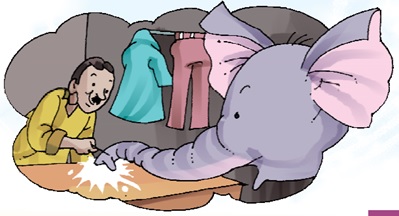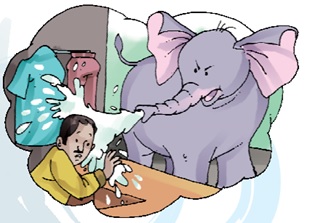Unit 10 | Prose | The Tailor and His Friend
TRANSACTION MODULE
Narration
Once there lived a tailor. His name was Kalu.
Kalu was a tailor. He had a shop near the river.
Kalu made colourful pants and shirts for children.
Appu the elephant was also his friend.
Appu came to his shop every day.
Kalu gave him many nice things to eat.
Appu and Kalu were good friends.
Interaction
1. Who was Kalu?
Elicit and write, ‘Kalu was the tailor’ on the BB.
(Note: Students may answer bit by bit. Teacher can accept these sort of responses in their mother tongue, too. But teacher has to say and write it in English.)
2. Who was Appu?
Elicit and write, ‘Appu was the elephant.’
3. Where was Kalu’s shop?
Elicit and write, ‘Kalu’s shop was near the river.’
4. Who came to Kalu’s shop every day?
Elicit and write, ‘Appu came to Kalu’s shop every day.’
5. Who did give many nice things to Appu?
Elicit and write, ‘Kalu gave many nice things to Appu.’
Narration
One day Kalu wanted to play a trick.
He did not give Appu anything to eat.
Instead, he did something else.
Kalu took a needle and pricked Appu’s trunk.
Interaction
1. What did Kalu want to play?
Elicit and write, ‘Kalu wanted to play a trick.’
2. Did he Appu give anything to eat?
Elicit and write, ‘He didn’t give anything to eat.
3. What trick did Kalu play on Appu?
Elicit and write, ‘He pricked Appu’s trunk.’
Show the picture:

Picture Interaction
1. What do you see in the picture?
(Students will come out with many answers. Accept all responses.)
2. Is Kalu having something in his hand? What is it?
Elicit and write, ‘It is a needle.’
3. What is he doing?
Elicit and write, ‘Kalu pricks Appu.’
Narration
Appu shouted in pain.
Ahhhh….ahh….
He ran out of the shop. He ran away.
Two days later, Appu came down to the river.
He filled his trunk with water.
Then he reached Kalu’s shop.
Do you want to know what happened next?
Show the picture

Picture Interaction
1. How does Appu look?
Elicit, ‘Appu is angry.’
2. What do you see in this picture?
Elicit and write, ‘Appu pours the water on Kalu.’
Narration
Appu threw water everywhere.
All the new clothes became wet.
Appu shook his trunk. (Teacher can do gesture for ‘shook’.)
He said, “An elephant never forgets.”
Kalu said, “I am sorry, Appu. Let’s be friends again.”
Interaction
1. What happened to all new clothes? Did all become wet?
Elicit and write, ‘All new clothes became wet.’
2. What did Appu do?
Elicit and write, ‘Appu shook his trunk.’
3. What did Appu say?
Elicit and write, ‘Appu said, “An elephant never forgets.”’
4. What did Kalu say?
Elicit and write, ‘I am sorry Appu. Let’s be friends again.’
Show the picture

Narration
Then, Kalu and Appu became friends again.
Interaction
1. What did happen finally? Did they become friends again?
Elicit and write, ‘They became friends again.’
Reading Process
Reading of the subtext: Ask students to take turn to read the elicited sentences from the blackboard.
- Individual reading: Students can then be encouraged the text from the textbook. Difficult words and lines can be underlined and clarified at the next step.
- Collaborative/Group reading: Students clarify their doubts at this stage. They take the support of their classmates and peers to read the text.
- Reading aloud by the teacher: After students have completed the above processes of reading, the teacher may engage them in listening to her version of reading the lesson. It should be read slowly, and care should be taken on the pause and intonation as it is being read.
Activity
Enacting the lesson as a drama
Students may be asked to get into groups. They may then be asked to decide on the location, theme, sequence, and other relevant drama components to be able to enact the lesson as a play in the class. When the students have enacted the drama, it is important that the teacher gives a feedback of their performance for them to be able to gain a better understanding of the lesson. This will also help in better language acquisition amongst students as they learn through association and implementation.
Term: Term 3
- Log in or register to post comments